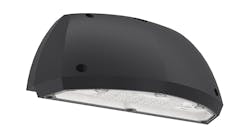MAURY WRIGHT interviews SCOTT SANTORO about how Fluxwerx approached LED-based luminaire development relative to the Sapphire Award-winning Fold SSL product family.
On March 1, 2017 in Anaheim, CA, LEDs Magazine announced the winners in the 2017 Sapphire Awards program at a Gala that took place coincident with the Strategies in Light tradeshow. LED luminaire specialist Fluxwerx won the Sapphire Indoor Troffer, Linear, and Recessed SSL Luminaire Design category for its Fold product as we documented in prior articles. We recently had a chance to talk with Scott Santoro, Fluxwerx vice president of product design, about the development process the Fluxwerx team uses, some details about the Fold development, and the team's feelings about the Sapphire Award win.
Interested in articles & announcements on LED-based architectural lighting?
LEDs Magazine: Hi Scott, and congratulations on winning an LEDs Magazine Sapphire Award for your Fluxwerx Fold luminaire. I want to start by asking you about the form factor. We have written repeatedly that LED sources can enable completely new concepts in luminaire design. Still, a lot of products on the market look like legacy fixtures with LEDs supplanting a lamp of some type. Clearly, Fold and some of your other products are far different from legacy fixtures. How does your team start a product development like Fold? Do you conceive of the shape and lines before even contemplating how to make it work optically? Is there an industrial design type process that happens before you tackle the electrical, mechanical, optical, and thermal problems?
Scott Santoro: Innovation is core to who we are at Fluxwerx. Since the inception of our company, our mantra has always been to do things that could not have been done before, and to ensure that any product that we create could actually only ever be done in LED and not be replicated in fluorescent.
Through years of experience and experimentation, we have developed an integrated approach that synthesizes all elements of design - industrial, optical, electrical, thermal, and mechanical - but to say that we start with any of those elements would be inaccurate. Design starts with a problem or an inspiration and begins with any one particular element, but we quickly integrate the other elements through a unique combination of iterative process and engineering savvy.
LEDs: Striking luminaire form is of course important in architectural lighting projects. But form without function just doesn't work for most lighting designers/specifiers. Can you summarize the optical performance that Fold delivers and perhaps contrast that summary with what linear pendant fixtures in more traditional form factors might offer?
Santoro: Our goal was to create a minimalist luminaire that contrasted sculptural mass and form of architectural materials with its own luminous void aperture that - in combination with our precision anidolic optics - delivers both design and visual comfort with superior lighting and energy performance with unmatched quality.
Optical performance is a function of two factors - the efficacy of converting the input energy to output light and, more importantly, the distribution of that light from the fixture in the space. The latter is often ignored in LED product design, and yet it is more important in that it is the element of lighting performance that creates the experience for the people occupying the space. The focus of optical design should be to deliver the light in a controlled distribution that is optimized for the application.
Efficacy is important but if it is the focus, then it ignores the most significant element - the people in the office, or school, or library, or retail space. It is not just about the technology itself, but about the end result and what that technology delivers.
The opportunity that has been created in designing optics for LED sources, that was not available with fluorescent and other legacy sources, is the integration of true precision lighting performance with architectural and industrial design that now exists in ways that could never be done before.
In short, Fold is the sum of optimal balance of all elements to deliver affordable, beautiful objects that create superior lighting performance and energy savings with architectural materials. Its indirect/direct batwing distributions are separately dimmable and deliver efficacy up to 119 lm/W with multiple CCTs, chromatic accuracy less than 2 SDCM, and extraordinary lumen maintenance of L70 at 200,000-plus hours.
LEDs: I understand that one of the key elements behind the performance of Fold is the optics that Fluxwerx developed for Fold and other products with unique geometries. You mentioned the word anidolic earlier and I have seen your literature describe the optic as "anidolic extraction optics." Can you describe in simple terms what that means? And maybe more succinctly, what was the goal of the optics design and how did you achieve the goals from a technology perspective?
Santoro: Our quest was to deliver electric light to the built environment in way that creates a human experience that feels as natural and innocuous as possible - similar to the way we experience light delivered through a window: vertically, transparently, and with no visibility of the source. But since the energy used to generate the light is reliant on electricity, it is important that we also provide that experience in a responsible, sustainable, and precise way that drives down consumption while enhancing the visual environment.
The word "anidolic" comes from the Greek root word "eidolon," which means "image." Typical optics used today in most fixtures are based on imaging optics that try to recreate the image of that source, typically using mirrors to reflect it out. Non-imaging optics, on the other hand, apply a very different approach. It is all about an efficient transfer of the flux specifically without recreating an image of the source. Fundamentally, that is exactly what we were trying to do: Capture as much light energy as possible and efficiently transfer it to a different location within the context of the luminaire that reads more like fenestration rather than fixture.
LEDs are concentrated, highly efficient, directional point sources of light, and therefore have created unique and different challenges in optical and product design than what was previously delivered by traditional fluorescent and other legacy sources. Our anidolic extraction optics addresses these challenges in two ways. We use anidolic optical structures to disperse and mix the light, eliminating any visible images of the LED point source and ensuring consistent color. Various extraction elements are then used to refract and reflect light directly and indirectly to precisely control the optical distribution.
LEDs: Do I understand correctly that light is emitted from planar optics on both sides of the Fold structure? Do those optics deliver both direct and indirect light? It appears that light is directed upwards into what is essentially a reflecting chamber. Is that accurate?
Santoro: There are a multitude of optical approaches that are combined in Fold. Light is indeed emitted from both interior planes of the luminaire, efficiently and precisely directed to create a batwing distribution in both the hemispheres, which gives the fixture its low brightness while simultaneously providing the ability to space the runs widely apart for aggressive and sustainable, energy-efficient design with power densities of typically between 0.30 and 0.50 W/ft2.
LEDs: Can you tell me about the way you implemented the light engine? Are the LEDs installed along the lower edge of the fixture?
Santoro: Just asking that question confirms the success of our approach. The invisible implementation of the LED sources is part of the magic. Visual comfort matched with material selection and the resultant high levels of performance are the best evidence that "what and why" we succeed in developing award-winning products are exactly the elements the market is asking for. As for the exactly "how" - well, frankly that's part of our secret formula. You don't see Dr. Pepper publishing their proprietary recipe for Coke and Pepsi to read, either.
LEDs: What were the challenges in the light engine design? How did you handle the thermal mitigation? What about the electrical power distribution and interconnect over the length of the fixture?
Santoro: Again, it never comes down just one element. Our greatest challenges are always a result of the fact that we never do anything that has previously been done by others. In fact, we rarely even do the things we ourselves have done successfully in the past. We are always pushing the boundaries of our own creativity including the materials, the processes, our suppliers' abilities, and our own expectations. The integration of the light engine into such a thin and elegant shape was of course very difficult, especially when overlaid with our high-level requirements for visual comfort and performance. Developing the design for such a slim profile with the tensile strength to deliver structural rigidity over the long runs and thermal dissipation for L90 at 100,000-plus hours, combined with the mechanical/electrical features for alignment and ease of installation without compromising aesthetics, performance, or price, was a challenging exercise. However, we are very pleased with the results. We pushed ourselves and our partners. Hopefully, this also pushes the industry forward, too.
LEDs: I know you have won a number of awards with Fold. I hope you consider the Sapphire Award among the top achievements. How did you make the decision to enter our Sapphire program? And what was the reaction of your product team to the win?
Santoro: Since its inception, the Sapphire Awards program has been highlighting the innovations and advancements in the LED industry. We chose to participate in this year's Sapphire Awards program because an informed jury of industry experts have the ability to accurately the assess solid-state lighting market both from technology and design perspectives, and that's where we believe we excel. The award confirms not just our achievement in design, but we hope also sets a standard to which others should apply their ingenuity rather than delivering products which unimaginatively deploy LED sources into regurgitated fluorescent designs and therefore offer no added value to the architecture or the human experience.
The entire Fluxwerx team is deeply passionate about designing and developing luminaires that deliver an intelligent combination of contemporary design and practical functionality. Our goal was to present to the jury of Sapphire Awards Fold's precision optics and architectural materials in order to highlight its uniqueness. As noted earlier, Fold delivers design and visual comfort with superior lighting and energy performance never possible with legacy sources, and we were excited to submit our product to be considered by such an esteemed group of lighting industry professionals.







